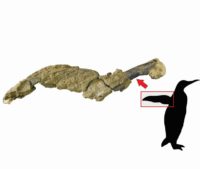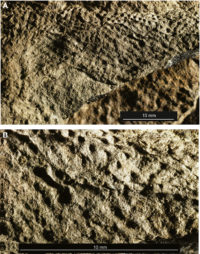 Argentine paleontologists have discovered the fossilized skin of Palaeeudyptes gunnari, a 43-million-year-old extinct large penguin. The whole wing was found during a 2014 excavation in the middle Eocene sediment layer on Seymour Island, Antarctica, the same place where the only known articulated skeleton of a Palaeeudyptes gunnari was unearthed in 2008.
Argentine paleontologists have discovered the fossilized skin of Palaeeudyptes gunnari, a 43-million-year-old extinct large penguin. The whole wing was found during a 2014 excavation in the middle Eocene sediment layer on Seymour Island, Antarctica, the same place where the only known articulated skeleton of a Palaeeudyptes gunnari was unearthed in 2008.
The entire wing was found and so much of it had been mineralized that researchers were able to study connective tissues, the feather follicles and a pattern left by the feathers on the skin. This is the only articulated wing of Palaeeudyptes gunnari ever found, the first skin from an extinct penguin ever found and the earliest example of mineralized skin from a neornithine bird (the more advanced avian species that survived the Cretaceous mass extinction event to become modern birds) whose skin was preserved.
“The skin has been preserved as a fossil on both surfaces of the wing, packing the bones that have been articulated in their original position, including the elements that ossify from the tendons,” said paleontologist Acosta Hospitaleche.
She added: “This has given us the opportunity to analyze the connective tissue of the wing, and the morphology and density of the skin follicles where the feathers are inserted.”
 This unique opportunity allowed researchers to establish that compared to the larger penguin species alive today like the emperor penguin, Palaeeudyptes gunnari had less dense plumage, an adaptation that would have helped insulate against the cold. Antarctica was not covered in ice in the Eocene (56 – 34 million years ago); it was a woodland environment rich with fauna. The adaptability of their plumage to extreme cold likely played a role in their success as a species during the Eocene and in the success of their descendants in the cold seas of the southern hemisphere.
This unique opportunity allowed researchers to establish that compared to the larger penguin species alive today like the emperor penguin, Palaeeudyptes gunnari had less dense plumage, an adaptation that would have helped insulate against the cold. Antarctica was not covered in ice in the Eocene (56 – 34 million years ago); it was a woodland environment rich with fauna. The adaptability of their plumage to extreme cold likely played a role in their success as a species during the Eocene and in the success of their descendants in the cold seas of the southern hemisphere.